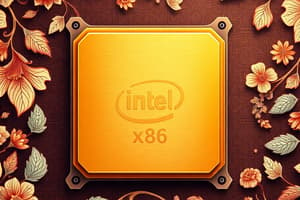Podcast
Questions and Answers
What is the primary function of the central processing unit (CPU)?
What is the primary function of the central processing unit (CPU)?
- Stores data permanently
- Manages all power supply functions
- Transmits data to external devices
- Controls the operation of the computer and performs data processing (correct)
What component of the CPU is responsible for performing arithmetic and logic operations?
What component of the CPU is responsible for performing arithmetic and logic operations?
- Arithmetic and Logic Unit (ALU) (correct)
- Registers
- Main memory
- Control unit
Which component is responsible for the internal storage within the CPU?
Which component is responsible for the internal storage within the CPU?
- Main memory
- Registers (correct)
- System bus
- Cache memory
What mechanism allows for communication among the CPU, main memory, and I/O devices?
What mechanism allows for communication among the CPU, main memory, and I/O devices?
In what manner do CPUs typically connect internally for their operations?
In what manner do CPUs typically connect internally for their operations?
What is the primary difference between computer architecture and computer organization?
What is the primary difference between computer architecture and computer organization?
Which of the following is considered an architectural attribute?
Which of the following is considered an architectural attribute?
According to Moore's Law, what is the prediction about transistors?
According to Moore's Law, what is the prediction about transistors?
What might influence the decision of whether a multiply instruction is implemented by a special multiply unit?
What might influence the decision of whether a multiply instruction is implemented by a special multiply unit?
Which statement about Moore's Law is true?
Which statement about Moore's Law is true?
How can different models within the same computer family differ?
How can different models within the same computer family differ?
Which of the following best describes the concept of organizational attributes?
Which of the following best describes the concept of organizational attributes?
What is a potential consequence of changes in technology on computer organization?
What is a potential consequence of changes in technology on computer organization?
What is the primary principle behind single-electron tunnelling (SET) transistors?
What is the primary principle behind single-electron tunnelling (SET) transistors?
Which architecture is mainly utilized in non-embedded computer systems?
Which architecture is mainly utilized in non-embedded computer systems?
Which of the following describes the function of a computer's data storage?
Which of the following describes the function of a computer's data storage?
What type of architecture is ARM classified as?
What type of architecture is ARM classified as?
What layer of computer structure allows designers to focus on interrelated subsystems?
What layer of computer structure allows designers to focus on interrelated subsystems?
The latest x86 architectures incorporate which of the following design principles?
The latest x86 architectures incorporate which of the following design principles?
Which crucial function involves managing the interaction between the computer and the external environment?
Which crucial function involves managing the interaction between the computer and the external environment?
What is NOT considered a primary function of a computer?
What is NOT considered a primary function of a computer?
Flashcards are hidden until you start studying
Study Notes
Computer Architecture & Organization
- Architecture defines the attributes visible to a programmer, impacting program execution, including the instruction set, data representation, I/O mechanisms, and memory addressing techniques.
- Organization details how hardware units are interconnected to realize the architectural specifications, like control signals, peripheral interfaces, and memory technology, invisible to the programmer.
- Moore's Law postulates that transistor density on integrated circuits doubles approximately every two years.
- SET Transistors are based on quantum tunneling, observed when electrons "tunnel" through a thin insulating barrier.
- Intel x86 Architecture is widely used in non-embedded systems, characterized by a complex instruction set computer (CISC) design with some RISC features.
- ARM Embedded Architecture is prevalent in embedded devices like cell phones, iPods, and sensors, featuring a reduced instruction set computer (RISC) design.
Computer Structure and Function
- Computer structure is hierarchical, with interconnected subsystems arranged in a sequential order.
- Data Processing: Computers handle data in various forms and perform processing operations.
- Data Storage: Computers store data both temporarily and permanently.
- Data Movement: Computers transfer data between themselves and the external environment.
- Control: A control mechanism manages the functions of data processing, storage, and movement.
Computer Structural Components
- Central Processing Unit (CPU): Controls the computer's operation and executes data processing functions.
- Main Memory: Stores data.
- I/O: Facilitates data transfer between the computer and its external environment.
- System Interconnection: A mechanism that allows communication between the CPU, main memory, and I/O, often using a system bus.
CPU Structural Components
- Control Unit: Manages the CPU's operation and thus the entire computer.
- Arithmetic and Logic Unit (ALU): Performs data processing tasks within the computer.
- Registers: Provide internal storage within the CPU.
- CPU Interconnection: A mechanism that enables communication among the control unit, ALU, and registers.
Studying That Suits You
Use AI to generate personalized quizzes and flashcards to suit your learning preferences.




